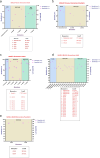Extracellular vesicle-mediated approaches for the diagnosis and therapy of MASLD: current advances and future prospective
- PMID: 39773634
- PMCID: PMC11705780
- DOI: 10.1186/s12944-024-02396-3
Extracellular vesicle-mediated approaches for the diagnosis and therapy of MASLD: current advances and future prospective
Abstract
Metabolic dysfunction-associated steatotic liver disease (MASLD) is an asymptomatic, multifaceted condition often associated with various risk factors, including fatigue, obesity, insulin resistance, metabolic syndrome, and sleep apnea. The increasing burden of MASLD underscores the critical need for early diagnosis and effective therapies. Owing to the lack of efficient therapies for MASLD, early diagnosis is crucial. Consequently, noninvasive biomarkers and imaging techniques are essential for analyzing disease risk and play a pivotal role in the global diagnostic process. The use of extracellular vesicles has emerged as promising for early diagnosis and therapy of various liver ailments. Herein, a comprehensive summary of the current diagnostic modalities for MASLD is presented, highlighting their advantages and limitations while exploring the potential of extracellular vesicles (EVs) as innovative diagnostic and therapeutic tools for MASLD. With this aim, this review emphasizes an in-depth understanding of the origin of EVs and the pathophysiological alterations of these ectosomes and exosomes in various liver diseases. This review also explores the therapeutic potential of EVs as key components in the future management of liver disease. The dual role of EVs as biomarkers and their therapeutic utility in MASLD essentially highlights their clinical integration to improve MASLD diagnosis and treatment. While EV-based therapies are still in their early stages of development and require substantial research to increase their therapeutic value before they can be used clinically, the diagnostic application of EVs has been extensively explored. Moving forward, developing diagnostic devices leveraging EVs will be crucial in advancing MASLD diagnosis. Thus, the literature summarized provides suitable grounds for clinicians and researchers to explore EVs for devising diagnostic and treatment strategies for MASLD.
Keywords: Biomarker; Extracellular vesicles; Liver diseases; Metabolic dysfunction-associated steatotic liver disease; Targeted therapy.
© 2025. The Author(s).
Conflict of interest statement
Declarations. Ethics approval and consent to participate: Not applicable. Consent for publication: Not applicable. Competing interests: The authors declare no competing interests.
Figures




Similar articles
-
Role and therapeutic perspectives of extracellular vesicles derived from liver and adipose tissue in metabolic dysfunction-associated steatotic liver disease.Artif Cells Nanomed Biotechnol. 2024 Dec;52(1):355-369. doi: 10.1080/21691401.2024.2360008. Epub 2024 Jun 4. Artif Cells Nanomed Biotechnol. 2024. PMID: 38833340 Review.
-
Extracellular Vesicles and Their Correlation with Inflammatory Factors in an Experimental Model of Steatotic Liver Disease Associated with Metabolic Dysfunction.Metab Syndr Relat Disord. 2024 Jun;22(5):394-401. doi: 10.1089/met.2023.0284. Epub 2024 Mar 18. Metab Syndr Relat Disord. 2024. PMID: 38498801
-
Extracellular vesicles as a potential source of biomarkers for endocrine disruptors in MASLD: A short review on the case of DEHP.Biochimie. 2025 Jan;228:127-137. doi: 10.1016/j.biochi.2024.09.009. Epub 2024 Sep 21. Biochimie. 2025. PMID: 39307409 Review.
-
Intestinal bacteria-derived extracellular vesicles in metabolic dysfunction-associated steatotic liver disease: From mechanisms to therapeutics.Mol Cells. 2025 Jun;48(6):100216. doi: 10.1016/j.mocell.2025.100216. Epub 2025 Apr 14. Mol Cells. 2025. PMID: 40239896 Free PMC article. Review.
-
Roles of extracellular vesicles from different origins in metabolic-associated fatty liver disease: progress and perspectives.Front Immunol. 2025 Mar 10;16:1544012. doi: 10.3389/fimmu.2025.1544012. eCollection 2025. Front Immunol. 2025. PMID: 40129979 Free PMC article. Review.
Cited by
-
Pathogenesis and Clinical Management of Metabolic Dysfunction-Associated Steatotic Liver Disease.Int J Mol Sci. 2025 Jun 14;26(12):5717. doi: 10.3390/ijms26125717. Int J Mol Sci. 2025. PMID: 40565181 Free PMC article. Review.
-
Exosome Therapy: A Promising Avenue for Treating Intervertebral Disc Degeneration.Tissue Eng Regen Med. 2025 Aug 7. doi: 10.1007/s13770-025-00746-5. Online ahead of print. Tissue Eng Regen Med. 2025. PMID: 40773150 Review.
-
The Role of Extracellular Vesicles in the Pathogenesis of Metabolic Dysfunction-Associated Steatotic Liver Disease and Other Liver Diseases.Int J Mol Sci. 2025 May 23;26(11):5033. doi: 10.3390/ijms26115033. Int J Mol Sci. 2025. PMID: 40507843 Free PMC article. Review.
References
-
- Wu J, Fu Y, Chen D, Zhang H, Xue E, Shao J, et al. Sedentary behavior patterns and the risk of non-communicable diseases and all-cause mortality: A systematic review and meta-analysis. Int J Nurs Stud. 2023;1(146):104563. - PubMed
Publication types
MeSH terms
Substances
LinkOut - more resources
Full Text Sources

